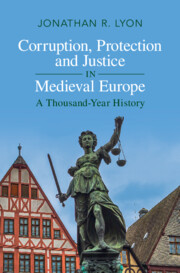Book contents
- Corruption, Protection and Justice in Medieval Europe
- Corruption, Protection and Justice in Medieval Europe
- Copyright page
- Dedication
- Contents
- Maps and Figures
- Acknowledgments
- Abbreviations
- Additional material
- Introduction
- 1 The First “Medieval” Advocates
- 2 Putting Down Roots in Ninth-Century Francia
- 3 The “Aristocratization” of Post-Carolingian Advocacy
- 4 Elite Competition at the Turn of the First Millennium
- 5 The Limits of Church Reform
- 6 Pigs and Sheep, Beer and Wine, Pennies and Pounds
- 7 A History of Violence
- 8 Weapons of the Not-So-Weak
- 9 The Murder of Archbishop Engelbert
- 10 Widening the Lens
- 11 The Emperor as Vogt, ca. 1000–1500
- 12 From Lordship to Government?
- 13 Reframing the History of Violence
- 14 Crossing the False Divide
- 15 A Cultural History of the Rapacious Advocate, or: William Tell’s Revenge
- Conclusion
- Works Cited
- Index
4 - Elite Competition at the Turn of the First Millennium
Published online by Cambridge University Press: 12 October 2022
- Corruption, Protection and Justice in Medieval Europe
- Corruption, Protection and Justice in Medieval Europe
- Copyright page
- Dedication
- Contents
- Maps and Figures
- Acknowledgments
- Abbreviations
- Additional material
- Introduction
- 1 The First “Medieval” Advocates
- 2 Putting Down Roots in Ninth-Century Francia
- 3 The “Aristocratization” of Post-Carolingian Advocacy
- 4 Elite Competition at the Turn of the First Millennium
- 5 The Limits of Church Reform
- 6 Pigs and Sheep, Beer and Wine, Pennies and Pounds
- 7 A History of Violence
- 8 Weapons of the Not-So-Weak
- 9 The Murder of Archbishop Engelbert
- 10 Widening the Lens
- 11 The Emperor as Vogt, ca. 1000–1500
- 12 From Lordship to Government?
- 13 Reframing the History of Violence
- 14 Crossing the False Divide
- 15 A Cultural History of the Rapacious Advocate, or: William Tell’s Revenge
- Conclusion
- Works Cited
- Index
Summary
This chapter argues that, starting around the year 1000, evidence for monasteries and churches complaining about their advocates’ bad behavior steadily grows. While much of the most dramatic rhetoric about advocates’ abuses comes from the West Frankish Kingdom, there is also evidence that East Frankish ecclesiastics began to have problems with their advocates during the same period. As a result, this chapter does not frame advocates’ abuses in terms of the debate around the Feudal Revolution/Mutation/Transformation of the year 1000 (which mostly focuses on West Francia). Instead, it argues that, as high-ranking nobles (especially counts and dukes) increasingly acquired church advocacies, they used their local power and authority to push the limits of their responsibilities as advocates, sometimes coming into conflict with monasteries and churches in the process. This was not a form of violent or anarchic lordship, but a strategy to use the well-established responsibilities of advocates on ecclesiastical estates to their own advantage.
- Type
- Chapter
- Information
- Corruption, Protection and Justice in Medieval EuropeA Thousand-Year History, pp. 86 - 107Publisher: Cambridge University PressPrint publication year: 2022



